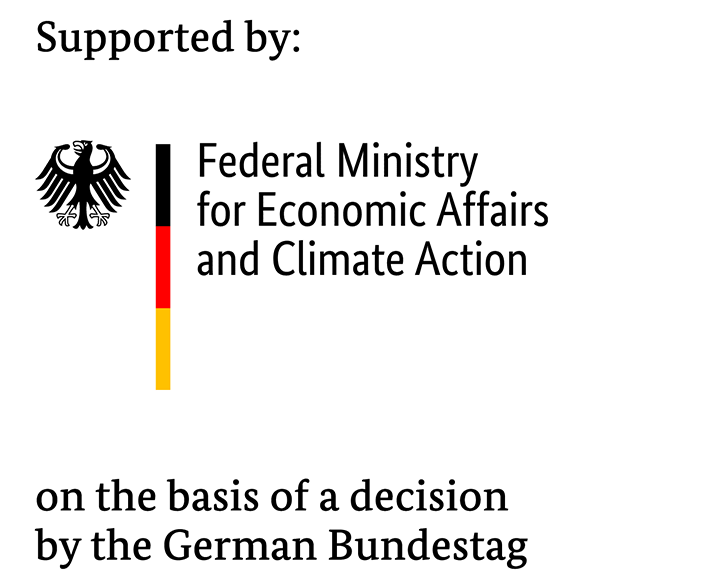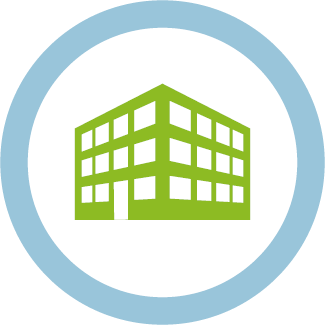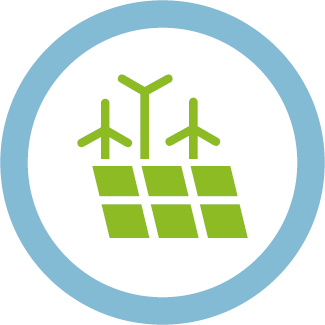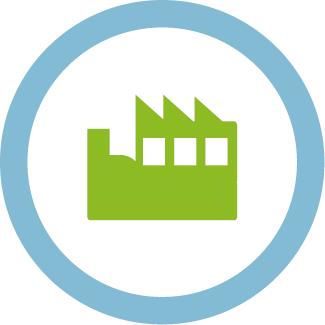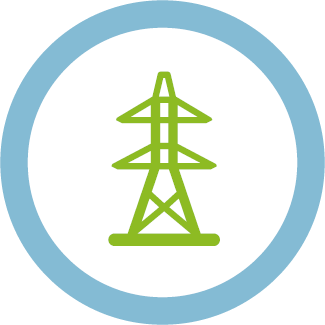Energy Transition Construction Research Network

On the road to the energy transition in buildings and neighbourhoods, the Energy Transition Construction research network is an important element in increasing the transparency and efficiency of funding policy in this area.
The Energy Transition Construction research network brings together experts from the fields of research and industry on the topic of buildings and neighbourhoods and promotes a sharing of experience between them via transparent, open structures. The stakeholders represented in the research network include university research institutions, planners, architects, manufacturers, and professional associations. Regular exchange with subject specialists from the Federal Ministry for Economic Affairs and Climate Action (BMWK) is ensured by a specialized advisory council.
This intense exchange allows research results to be put to practical use and research funding to evolve. The funding topics from the area of buildings and districts are bundled in the energy research program via the members of the network.
Funding priority for buildings and neighbourhoods
The funding topics from the area of buildings and neighbourhoods are shared by the network’s members: Energy-saving buildings, integrative energy concepts, and innovative, economical, and reliable supply structures in neighbourhoods all make crucial contributions to ensuring a successful transition of the energy and heating systems in Germany.
The Federal Government is aiming to achieve a virtually carbon-neutral building stock by 2045. Along with the development of individual technologies, the focus of research in the network is the systemic interaction of buildings and neighbourhoods, both with each other and with the overall energy infrastructure.
Decentralized supply structures are on the increase and, as the electricity, heating, transport, and mobility sectors become interlinked, buildings and neighbourhoods will have to interact with the electricity system more and more in future, making a flexible and grid-based energy supply necessary. In all research activities, questions of acceptance also have to be kept in mind when addressing challenges related to energy, sustainability, and resources.
Collaboration in the Energy Transition Construction research network
Work in the Energy Transition Construction research network is carried out flexibly across ten self-organized working groups, which are all interconnected and in constant communication via an online platform. Each working group addresses one topic relating to researching, developing, planning, building, and operating energy-optimized buildings and neighbourhoods. The working groups are open to all experts who are interested and are registered in the Energy Transition Construction research network.
The groups’ spokespersons act as subject-specific points of contact. All registered participants in the research network’s online platform receive more information about the current members of the working groups, access to the minutes and lists of attendees from the network events, and the chance to participate in activities such as opinion polls.
The energetic performance of buildings and neighbourhoods increases when the interfaces between machines and humans are optimized. The working group’s focus is therefore on one existing and several newly developed technical solutions on the one hand, and on other stakeholders such as users, decision-makers, planners, and those implementing the solutions on the other hand. The job of research and development is to remove obstacles to implementing and operating energy-optimized buildings and neighbourhoods, and to harness the potential of the human/machine interface for practical use. For example, this includes methods and instruments that support and improve knowledge transfer and thus ensure that the diverse expert knowledge from the individual scientific disciplines about correlations and requirements is more effectively transferred between those involved in the relevant projects. These methods and instruments can guarantee quality management for the entire life cycle of a building, optimize processes, and increase acceptance among a building’s or a neighbourhood’s users by actively integrating them into the process.
The responsible contact persons are still to be named.
The integration of renewable energy into heating systems is of central importance in neighbourhoods. Issues from the areas of geothermal energy, solar thermal energy, and bioenergy in existing heat supply structures, and their efficient and economical integration, are the focus of this working group. It is important to think and act on a systemic basis, so that the energy transition in neighbourhoods is successful. This means that, as well as taking stock, it is necessary for example to make predictions for this area and to keep focused on realizing an interconnected heating and electricity infrastructure in order to achieve a virtually carbon-neutral energy supply in neighbourhoods.
The responsible contact persons are still to be named.
In a future supply system based on renewable energy, buildings can make an important contribution to stabilizing the system. The interconnection, analysis, and optimization of various components in building technology are the foundation of this. Intelligent measurement and control technology, along with the monitoring data measured, provide information about how components can be optimally used and how processes can be optimized during operation. This is necessary because only limited information about a building’s or a neighbourhood’s use and user behaviour is available during planning. Monitoring concepts with uniform interfaces and defined subsystems are therefore an important research topic in ensuring energy-efficient operation and reducing performance gaps in buildings.
Contact
Dr.-Ing. Stefan Plesser
E-Mail: plesser@igs.bau.tu-bs.de
Website: Institute for Building and Solar Technology (IGS) TU Braunschweig
Buildings are usually used over a very long time. With respect to the different aspects of sustainability, all stages of a building’s life have to be analysed and optimized in how they interact. The research field of life cycle considerations analyses and optimizes materials, costs, and social impacts with respect to production, demolition, and utilization technologies. Information about the actual quality of a building can only be gained once the entire life cycle has been taken into consideration. Life cycle assessments require consistent, reliable, and meaningful basic data. They provide transparency with respect to resource and energy efficiency, and can reveal potential raw material dependencies and systemic improvements.
The responsible contact persons are still to be named.
Analysis and planning tools calculate how the energy supply system, building envelope, and rooms should be designed. Their simulations make it possible for developers, architects, and planners to evaluate and compare scenarios and concepts so that existing economic and energy potential can be exploited. However, data protection and data security have to be taken into account when collecting, storing, processing, and preparing data. The definition of standardized ICT interfaces also plays a major role in the development of planning tools. The integration of innovative technologies and their interaction in the system are usually simulated in practice using different models with different levels of complexity and informative value. However, holistic systems analyses demand that processes be considered together. Generalizable, dynamic simulation and evaluation tools are in demand from research and development, while open source tools allow findings to be reused in follow-up projects. So far in practice there has not been a common standard for a shared data corpus for planning tools, simulation models, or verification and optimization procedures.
Contact
Prof. Dr.-Ing. Christoph van Treeck
E-Mail: treeck@e3d.rwth-aachen.de
Website: RWTH Aachen
The Federal Government is aiming to achieve a virtually carbon-neutral building stock by 2050. In order to reach this goal, it is important to look at buildings not just as energy consumers, but as producers of energy too. Electricity or heat can be produced from solar energy using active building envelopes such as solar facades and roofs. The available area for solar energy is greatly expanded by using a facade. Development of solar and solar thermal facades in particular has progressed a great deal in recent years, however further research is still needed. Along with component function, component design plays a crucial role in the context of acceptance.
Contact
Dr.-Ing. Harald Drück
E-Mail: drueck@itw.uni-stuttgart.de
Website: Institute for Thermodynamics and Thermal Engineering (ITW) Uni Stuttgart
To make buildings more energy efficient, individual components have to be further optimized and improved while also keeping the overall system and costs in consideration. Further development is needed in converting, storing, and distributing energy. Coupling different energy sources with energy storage and intelligent grids is essential for energy-efficient buildings that benefit the grid. Moreover, in housing construction, new functionalities need to be integrated that previously did not exist or were not yet automated. The more functionalities that are integrated into a system, the more important it is that users accept and can use the system, aside from the technical aspects. Standardization, certification, and verification methods are also essential for practical use, as without them it is impossible to ensure that the building systems technology works in an energy-efficient and user-centric way in the long term. When more and more functionalities, energy sources, and storage facilities are combined into an overall system, it must be ensured that the optimal level of complexity is settled on and that the system can be easily managed both during construction and when in use.
Contact
Dr.-Ing. Karin Rühling
E-Mail: karin.ruehling@tu-dresden.de
Website: Technische Universität Dresden
In the 7th Energy Research Programme, the Federal Government has extended its funding options for applied energy research by introducing a new format involving “regulatory sandboxes for the energy transition”. These sandboxes are intended to accelerate technology and innovation transfer by acting as testing spaces for innovation and regulation. The idea for this format came from the energy research networks – as did the inspiration for the “EnEff.Gebäude.2050” ideas competition. As part of this funding initiative, a total of € 280,000 in prize money was awarded to ten outstanding and innovative concepts in 2017. The jury selected five winners in each category, namely the category of concepts for pioneering buildings and neighbourhoods and the category of ideas for an international energy competition. The competition was the basis for Germany’s successful bid to host the Solar Decathlon Europe event in 2021, which the Energy Endeavour Foundation awarded to Wuppertal in January 2019. Furthermore, this working group maintains close contact with the Start-Ups research network.
Contact
Prof. Dr. Gunnar Grün
E-Mail: gunnar.gruen@ibp.fraunhofer.de
Website: Fraunhofer-Institute for Building Physics IBP
Complex and interconnected technologies, as well as buildings and neighbourhoods, require specialists from every field. Energy-efficient renovations and the optimization of buildings and neighbourhoods can only succeed if all occupational groups, including tradespeople, engineers, architects, and scientists, work together to develop and implement the best possible solutions for construction, operation, maintenance, and refurbishment. It is therefore necessary to connect the research, planning, implementation, and operation phases more effectively than has been the case so far. New avenues are also opening up within education for advancing the goals of mutual understanding and providing the necessary qualifications and training. Interdisciplinary action and thinking, along with a restructuring of existing planning and design procedures, are the first steps to achieving holistic, integral planning and practical implementation.
Contact
Prof. Katja Biek
E-Mail: biek@beuth-hochschule.de
Website: Berliner Hochschule für Technik
In the medium to long term, solar thermal power opens up the possibility of supplying single-family and multi-family houses with environmentally friendly and economical heating. Ideally, the system heats both the building and the drinking water. Research and development are working on developing these combined systems further and on increasing coverage, since in practice a solar thermal power system cannot meet a building’s full demand for heating energy. That is why the system has to be connected to a conventional heating system. Solar process heat systems can generate much greater yields for providing hot drinking water or space heating. Many more system variants are also possible due to the large number of promising industrial processes. Solar heat can, for example, be fed into the system via industrial hot water, via a steam network, or at the process level. Intelligent and efficient solutions for integrating solar thermal power technologies into a building’s energy supply system, and beyond that into a neighbourhood’s heating network, are also in demand.
Contact
Dr. Harald Drück
E-Mail: drueck@itw.uni-stuttgart.de
Website: Universität Stuttgart – Institute for Building Energetics, Thermotechnology and Energy Storage
Sustainable, efficient and economical solutions are needed for the heat transition in buildings and neighborhoods. Geothermal energy as a renewable energy source already offers numerous solutions for the climate-friendly provision of heating and cooling. In the future, the seasonal storage of thermal energy, for example in aquifer reservoirs, will gain in importance. The working group sees priorities in promoting innovative and integrative approaches and reducing risks and costs. Furthermore, the network aims to increase the awareness and acceptance of geothermal energy and to develop suitable participation formats. The Geothermal Energy Working Group compiles research results and supports their transfer into practice in order to make a decisive contribution to a nearly climate-neutral building stock by the year 2050.
Contact
Dr. André Deinhardt
E-Mail: andre.deinhardt@geothermie.de
Website: German Geothermal Association
Accompanying research for energy transition construction
The accompanying scientific research team analyses and compares all projects with BMWK funding in the field of energy for buildings and neighbourhoods, and organizes the professional exchange of information between the research projects by means of various event formats.
In doing so, the teams of scientists aim of gaining a systematic overview of the research projects. Some of the typical questions they ask are “what can we learn from all of these projects together?” and “what issues are going to be important in the future?”. For answers to these questions, they turn to advisers such as the representatives of the individual funding projects.
In this way, the accompanying research team detects trends and identifies techniques and tools that may play an important role in the construction sector in the future. Their systematic analyses create synergies and encourage the scientists to exchange their expertise and results across projects, for example at workshops, project leader meetings, and conferences.
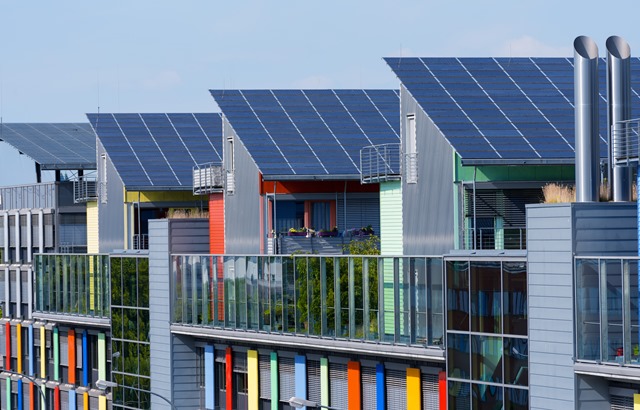
Teams evaluate research into energy-optimized buildings and neighbourhoods
The modules of the scientific accompanying research Energiewendebauen are each assigned to one of the following focal points:
- Monitoring, documentation, networking and knowledge transfer module
- Buildings module
- Neighborhoods module
- Digitization module
A detailed overview of the modules and composition of the four consortia can be found on the specialist portal energiewendebauen.de.
The team of scientists from the Fraunhofer Institute for Solar Energy Systems (ISE), the University of Wuppertal (BUW), and the Department of Sustainable Systems Engineering (INATECH) at the University of Freiburg evaluates model innovation projects that prepare technologies and procedures at an advanced stage of development for market launch. They also work to mitigate technical, economic, and societal barriers to implementation and highlight innovative avenues for implementing energy concepts.
- Energy Research Networks
- Bioenergy Research Network
- Energy Transition Construction Research Network
- Energy Transition and Society Research Network
- Renewable Energy Research Network
- Industry and Commerce Research Network
- Power Grids Research Network
- System Analysis Research Network
- Hydrogen Research Network

